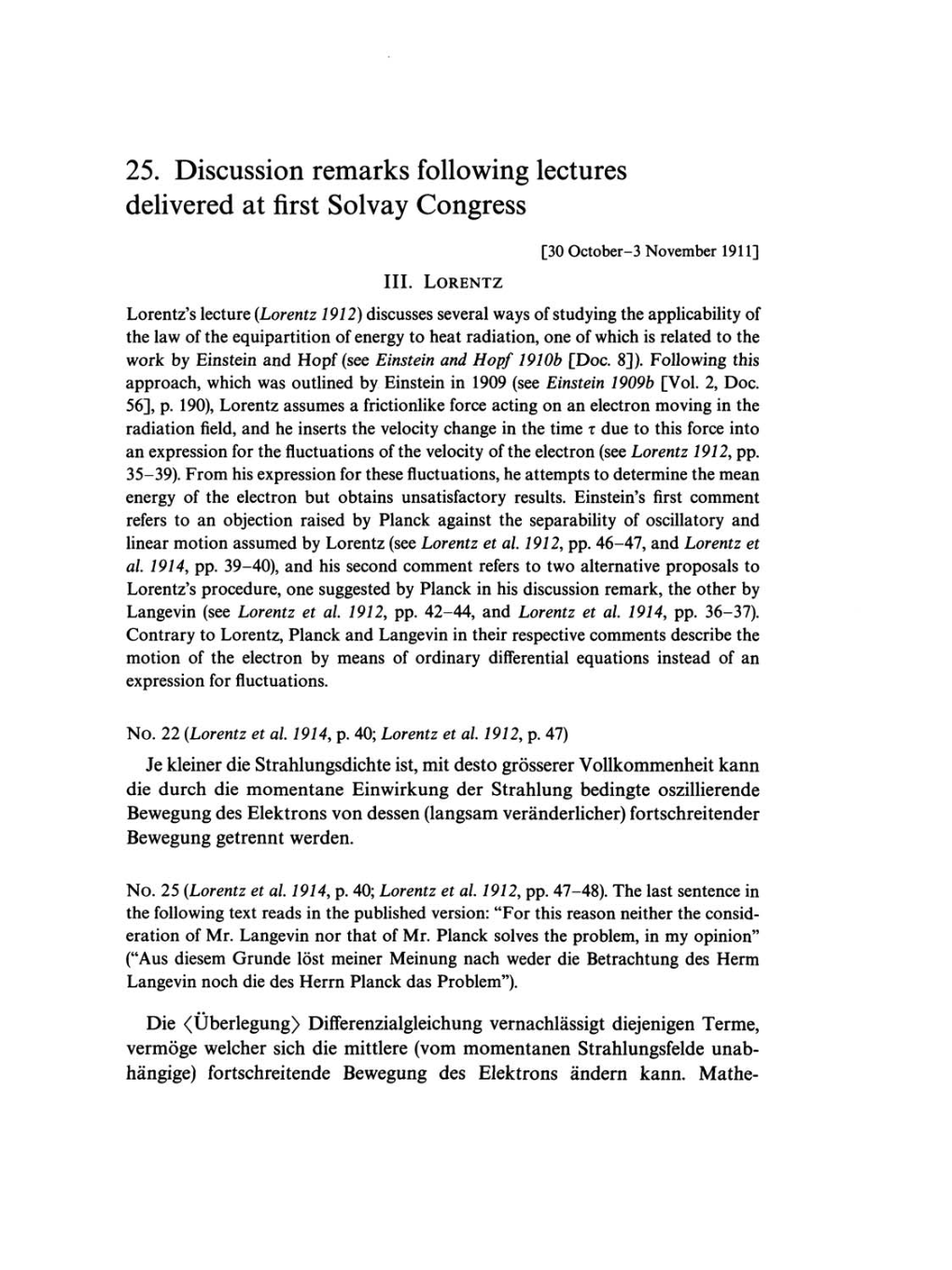25.
Discussion remarks
following
lectures
delivered
at
first
Solvay
Congress
[30
October-3
November
1911]
III.
LORENTZ
Lorentz's lecture
(Lorentz
1912)
discusses
several
ways
of
studying
the
applicability
of
the law of
the
equipartition
of
energy
to
heat
radiation,
one
of
which is
related
to
the
work
by
Einstein and
Hopf
(see
Einstein and
Hopf 1910b
[Doc.
8]).
Following
this
approach,
which
was
outlined
by
Einstein in
1909
(see
Einstein 1909b
[Vol. 2,
Doc.
56],
p.
190),
Lorentz
assumes a
frictionlike
force
acting
on an
electron
moving
in the
radiation
field,
and
he
inserts the
velocity change
in
the time
t
due
to
this
force
into
an
expression
for the fluctuations of
the
velocity
of
the
electron
(see
Lorentz
1912,
pp.
35-39).
From
his
expression
for these
fluctuations, he
attempts
to
determine the
mean
energy
of the electron but obtains
unsatisfactory
results.
Einstein's first
comment
refers to
an
objection
raised
by
Planck
against
the
separability
of
oscillatory
and
linear motion assumed
by
Lorentz
(see
Lorentz
et al.
1912,
pp.
46-47,
and Lorentz
et
al.
1914,
pp.
39-40),
and
his
second
comment refers to two
alternative
proposals
to
Lorentz's
procedure,
one
suggested by
Planck in
his
discussion
remark,
the other
by
Langevin
(see
Lorentz
et al.
1912,
pp.
42-44,
and Lorentz
et al.
1914,
pp.
36-37).
Contrary
to Lorentz,
Planck and
Langevin
in
their
respective
comments
describe the
motion of the electron
by
means
of
ordinary
differential
equations
instead of
an
expression
for fluctuations.
No.
22
(Lorentz et
al.
1914,
p.
40;
Lorentz
et
al.
1912,
p. 47)
Je
kleiner
die
Strahlungsdichte ist,
mit desto
grösserer
Vollkommenheit kann
die
durch
die
momentane Einwirkung
der
Strahlung bedingte
oszillierende
Bewegung
des
Elektrons
von
dessen
(langsam
veränderlicher)
fortschreitender
Bewegung getrennt
werden.
No.
25
(Lorentz et
al.
1914,
p.
40;
Lorentz
et al.
1912,
pp.
47-48).
The last
sentence in
the
following
text reads in the
published
version: "For this
reason
neither the consid-
eration of Mr.
Langevin
nor
that
of Mr. Planck
solves
the
problem, in
my
opinion"
("Aus
diesem Grunde löst meiner
Meinung
nach
weder
die
Betrachtung
des
Herm
Langevin
noch
die des
Herrn Planck das
Problem").
Die
Uberlegung Differenzialgleichung vernachlässigt diejenigen Terme,
vermöge
welcher
sich
die mittlere
(vom
momentanen
Strahlungsfelde
unab-
hängige)
fortschreitende
Bewegung
des Elektrons ändern kann.
Mathe–
